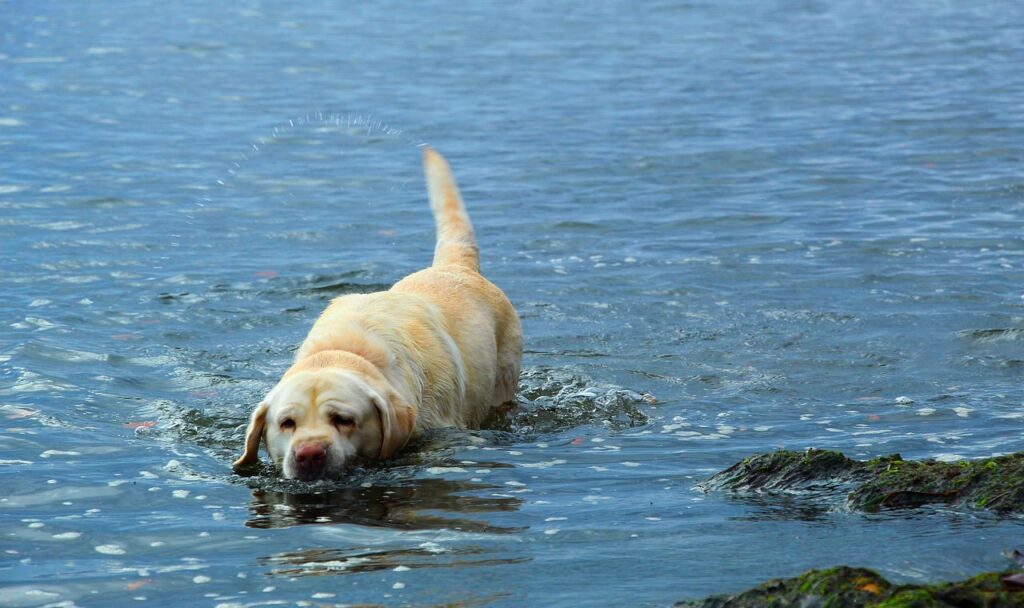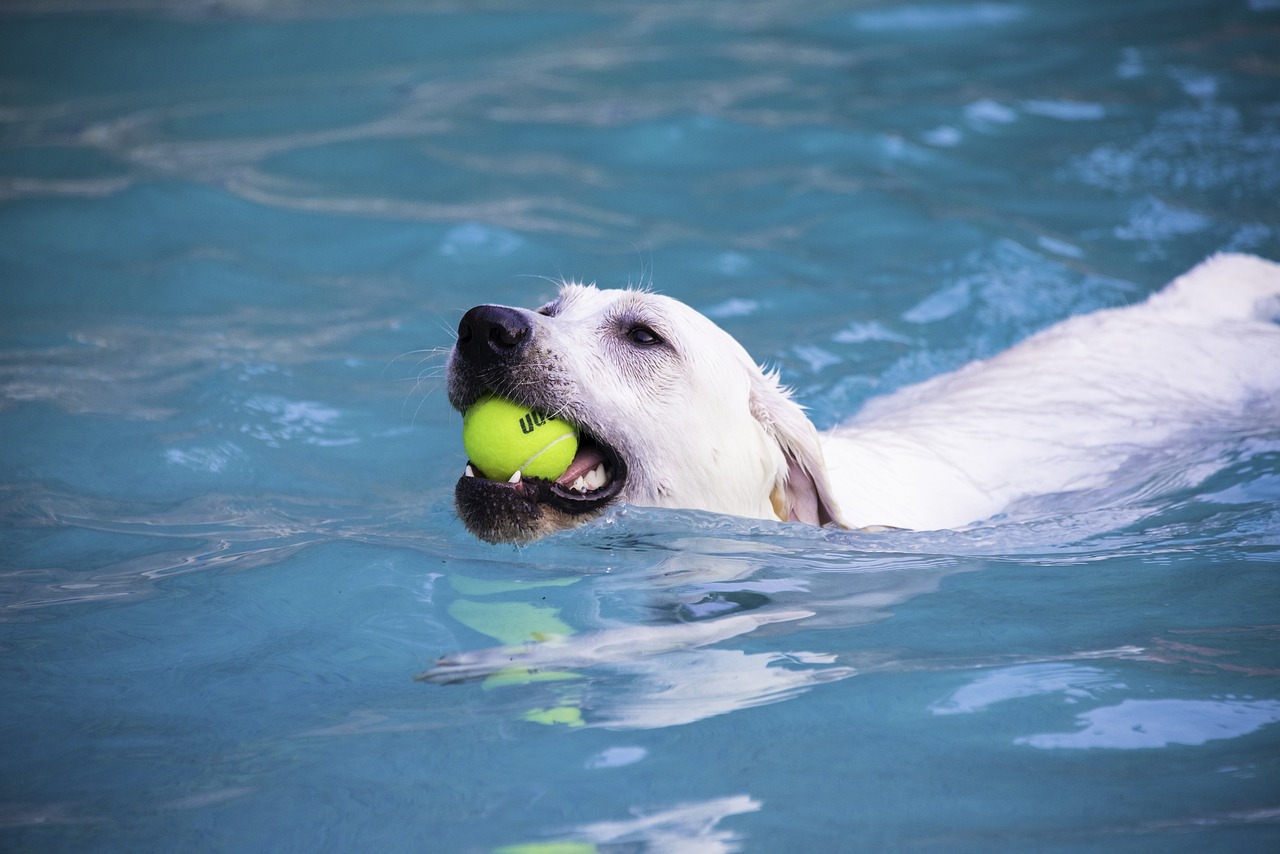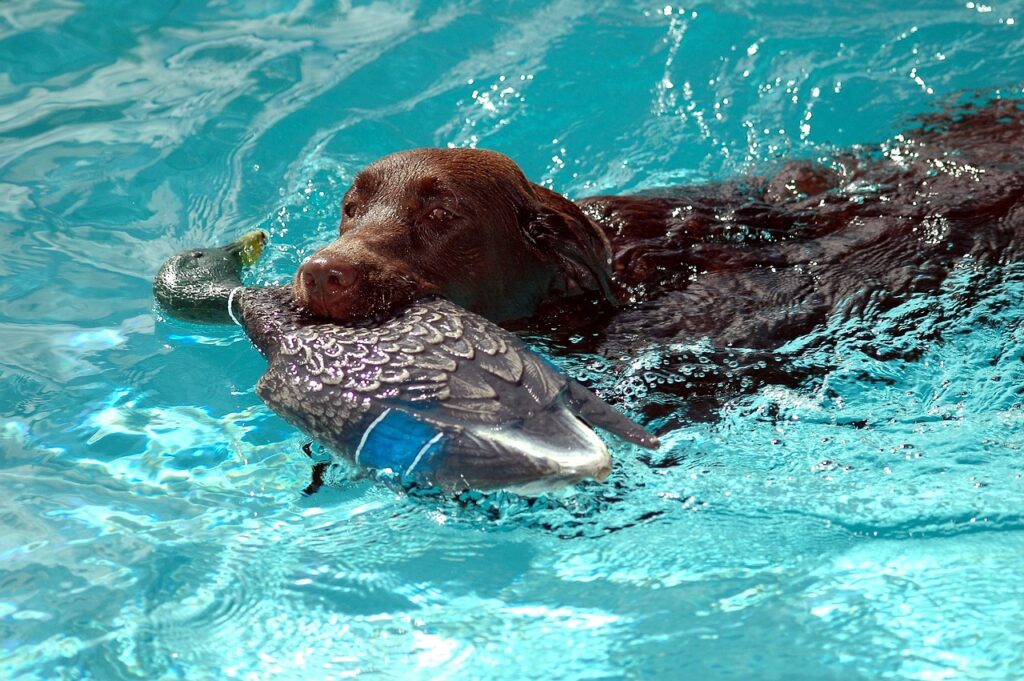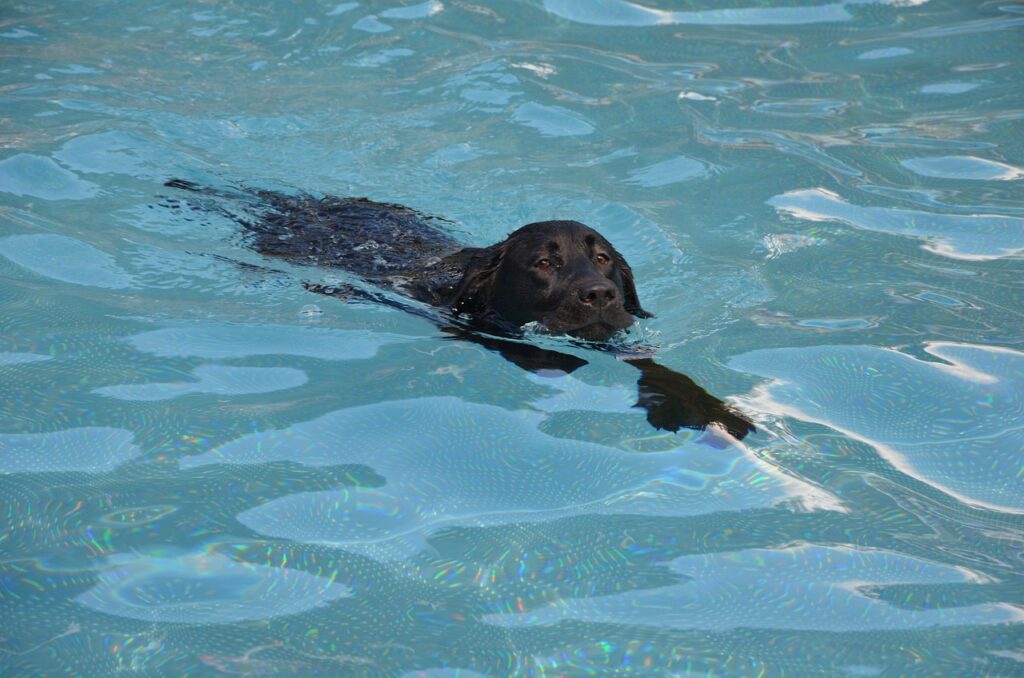Are Labrador Retrievers Good Swimmers?
Have you ever wondered, “are Labrador Retrievers good swimmers?” Well, it’s a question that might surprise many, considering the breed’s reputation as a water-loving canine. As one of the most popular dog breeds in the world, Labrador Retrievers are known for their friendly and outgoing nature.
Originating from Newfoundland (not Labrador, surprisingly), these sturdy canines were bred to retrieve fishing nets and swim in the cold Northern Atlantic seas, requiring strength, endurance, and exceptional swimming abilities.
So, do these historical traits translate into modern Labradors being good swimmers? Let’s dive into the fascinating world of Labradors and their swimming prowess to find out!
History of the Labrador Retriever Breed
Let’s take a little trip down memory lane, shall we? Picture Newfoundland in the early 1700s. It’s a place filled with hardy fishermen who rely heavily on their four-legged companions. These dogs, known as “St. John’s Dogs,” are the ancestors of our modern Labradors. They were invaluable to the fishermen, performing duties like retrieving fish and hauling in lines. And guess what? This often involved a lot of swimming!
Because of their work, these dogs were bred for physical strength and stamina but also for traits like a water-resistant coat (pretty handy in the icy waters, don’t you think?) and a unique ‘otter’ tail that acts like a powerful rudder in the water. Over time, English visitors to Newfoundland were so impressed with these St. John’s Dogs they imported them back to England, where they were crossbred and honed into the breed we now know as the Labrador Retriever.
So, you see, the connection between Labradors and water isn’t just a fluke—it’s a fundamental part of their history and breeding.
Physical Characteristics that Aid Swimming

For starters, have you ever taken a close look at your Lab’s paws? They’re not just cute; they’re practical! Labradors have webbed feet. Yep, you heard right – much like ducks or frogs, Labs have a bit of extra skin between their toes, which acts like a natural paddle, boosting their swimming speed and efficiency. Talk about a snazzy, built-in pair of flippers!
Next, a glossy coat. It’s not just there to make your Lab look like a canine supermodel. Your Lab’s double coat is short, dense, and water-resistant. That outer layer repels water, while the under layer provides insulation. So, even when it’s time for winter dips, your Lab stays fairly warm and dries off quickly post-swim.
And let’s not forget that robust, muscular build. Labs are strong and sturdy, with broad chests and strong limbs – perfectly designed for powerful and sustained swimming.
These are just a few of the many ways Mother Nature has ‘designed’ your Lab to be an absolute champ in water. It’s truly fascinating.
Innate Love for Water

You see Labradors, with their history as water-workers, have an inbuilt affinity for cold water that goes beyond mere physical attributes. It’s in their genes, their very DNA! That love of the water you see in your Lab isn’t just a preference—it’s a deeply-rooted instinct honed over hundreds of years of breed history. It’s as natural to them as wagging their tails or chasing a ball!
And what about swimming? You might have noticed how your Labrador Retriever takes to it like a duck to water. Again, that’s not a coincidence. Thanks to their ancestral lineage and purposeful breeding, labradors have the physical traits that make swimming easier and a natural inclination to swim. It’s almost as if the moment they find themselves in water, something clicks, and they just know what to do.
Isn’t that just fantastic? It’s like your Lab comes with an inbuilt “how to swim” manual! Their strong, rhythmic doggy paddle is a sight to behold and a testament to the dog breed’s adaptability and intelligence.
Training Labrador Retrievers to Swim
Of course, even with their natural swimming abilities, it pays to be vigilant and ensure your Lab is always safe in the water. That means supervising any swims and teaching them proper water safety rules.
With that said, it’s also essential to start training your Lab from a young age. The earlier you begin, the better! Exposing them to water in a safe and fun way will help them learn to love it – plus, they’ll be able to practice their swimming skills while getting used to the sensation of being in the water.
Here are some techniques that can help your Lab become an ace in the pool:
🐕 Select the Right Location
Choosing the right place for your Lab’s first swim is crucial. Start with something gentle, like a shallow pond or a kiddie pool in your backyard. The goal is to ensure your little furball feels safe and comfortable. You wouldn’t want their first swimming experience to be in a wild river or a deep pool – that can be way too overwhelming!
So, it’s like when we were kids, right? We didn’t start learning in the pool’s deep end, and the same applies to your Lab.
You can gradually introduce them to deeper waters once they’re comfortable in the shallow water.
🐕 Use a Dog Life Vest
You wouldn’t let your kid jump into the deep end without floaties, would you? The same goes for your Lab puppy! Dog life vests can be a real boon, especially in the initial stages of their swimming lessons. These vests provide extra buoyancy, keeping your dog afloat and boosting their confidence in the water. Plus, they typically come with handles on the top – so, if needed, you can pull your Lab out of the water quickly and safely.
Remember, though, a life vest isn’t a substitute for supervision. Always keep a keen eye on your furry friend during their aquatic adventures!
🐕 Get Inside the Water First
You, as a pet parent, play a vital role in your Lab’s swimming lessons. Why not get in there first instead of pushing them straight into the water? Show them how much fun you’re having! Splash around, show them that the water is nothing to be afraid of. Your Lab is likely to follow suit and join you in the water because, let’s face it, they hate to miss out on any fun!
Always be patient and encouraging. If they seem hesitant, don’t force them. Instead, coax them in with their favorite water-friendly toy or a few tasty treats. The goal is to make every swimming session a positive and enjoyable experience. Over time, they’ll associate water with good times and look forward to every swim!
🐕 Support Their Body
In the early stages of their swimming lessons, your Lab might need a bit of support – and that’s perfectly okay! Think about it, when you were little and learning to swim, someone probably held you up in the water, right? The same goes for your Labrador puppy! When in the water, gently support their body, keeping their rear end up. This will help them stay afloat and encourage them to use all four legs to swim, just like the pros!
🐕 Practice Short Sessions
When starting out, you don’t want to exhaust your furry pal by making swim sessions too long. They are just like us—too much of a new thing can be tiring. So, start with short, fun-filled sessions, maybe 5-10 minutes long.
Then gradually increase the time as your Lab gets more comfortable and stronger in the water. It’s just like human swimming lessons- you start with a few laps, and before you know it, you’re competing in a triathlon!
Also, don’t forget that even though they love it, swimming is a strenuous exercise for dogs. No matter how much your Lab appears to be enjoying it, make sure they have ample time to rest and catch their breath between swims.
🐕 Play Fetch in the Water
Guess what? Your Lab’s favorite game can also be a fantastic swimming lesson! Yep, you can use fetch toys to encourage your Lab to venture into the water. Start by throwing the toy a short distance into the water – somewhere your Lab can reach without having to swim. As they get more comfortable with the idea of wading into the water, gradually increase the distance, encouraging them to swim.
The key here is to make the whole experience fun and rewarding for your Lab. After all, nothing motivates quite like the promise of a good game of fetch!
🐕 Post-Swim Care
After a wonderful day of swimming, it’s important to show your Lab some post-swim love. Make sure to rinse them off thoroughly with fresh water to remove any chlorine, salt, or dirt that could irritate their skin or coat.
Don’t forget those ears! Labs are prone to ear infections, especially because of their water-loving nature. Clean their ears gently but thoroughly to ensure no water is left behind. There are special ear-cleaning solutions available for dogs, so consider keeping one handy.
Lastly, give your furry friend a good towel dry, ensuring they’re not damp. You can even consider using a dog-safe dryer if your Lab is comfortable with it.
🐕 Consistent Training
Like everything else in life, consistency is key when training your Lab to swim. It’s not a one-off thing, so don’t expect them to become Michael Phelps overnight. Rather, regular, consistent practice will help them grow more comfortable and confident in the water. Think of it as your weekly catch-up session with your best friend, except it’s in the water and involves a lot more fur.
🐕 Reward and Praise
In the end, every little success your Lab achieves in the water deserves a big celebration! It’s not just about learning to swim but about enjoying the process. So, whenever they make progress, no matter how small, shower them with praises and treats. Did they manage to stay afloat without any support for the first time? That’s treat-worthy!
Did they fetch a toy from the middle of the pool? Throw a mini-party right then and there! It’s all about positive reinforcement. Your Lab needs to know that they’re doing great and that you’re super proud of them. So, don’t skimp on the cheers and belly rubs, alright?
The Health Benefits of Swimming for Labrador Retrievers
Swimming is one of the most beneficial activities for Labradors. Not only does it help them stay healthy and fit, but regular swimming can also help alleviate a variety of health issues in these active dogs.
As they swim, Labradors build up their muscles as well as cardiovascular endurance, reducing the risk of obesity-related illnesses such as diabetes and heart problems. Moreover, swimming serves as a gentle exercise for your Labrador, exerting little stress on their joints. This means it’s particularly beneficial for older labs who suffer from joint pain or arthritis – the water provides much-needed relief from soreness and discomfort due to the buoyancy of the water.
Swimming will also help develop your Labrador’s balance and coordination while improving their cardiovascular system. Not to mention, it’s one of the best ways for them to stay cool in warm months! After all, no dog enjoys panting in the heat.
Overall, swimming is an excellent form of exercise for Labradors that will help keep them fit and healthy. Of course, it’s important to ensure regular vet visits and check-ups, just to be extra sure. And, as with all exercise routines, make sure that your Lab has plenty of time for relaxation in between swims.
Frequently Asked Questions
Q: Is a Labrador Retriever a natural swimmer?
Yes, Labrador Retrievers are naturally adept at swimming. These dogs were originally bred for water-related work, such as retrieving fishing nets or games from bodies of water. Because of this, they developed certain physical characteristics, like a rudder-like tail and webbed feet, that make them excellent swimmers.
Q: How does a Labrador Retriever’s swimming ability compare to other water dogs like the Golden Retriever or Chesapeake Bay Retriever?
Labrador Retrievers are on par with other water dogs, such as the Golden Retriever and Chesapeake Bay Retriever, when it comes to swimming. All three breeds share a love for water and are excellent swimmers thanks to their water-resistant coats, strong legs, and webbed paws.
Q: Are Yellow Labs as good at water activities as other Labrador Retrievers?
Absolutely! The color of a Labrador Retriever, whether black, chocolate, or yellow, does not impact their swimming ability. Yellow Labs are just as enthusiastic and capable in water as their counterparts.
Q: How does the American Kennel Club rate the swimming ability of the Labrador Retriever?
The American Kennel Club recognizes the Labrador Retriever as a top breed for water activities. With its history as working dogs in water environments, the breed is renowned for its swimming prowess and ability to retrieve from water.
Q: What other dog breeds are known for being good swimmers?
A: Other dog breeds known for their swimming ability include the Newfoundland, Portuguese Water Dog, Golden Retriever, Spanish Water Dog, German Shepherd, Boykin Spaniel, American Water Spaniel, Irish Water Spaniel, and Standard Poodle. While these breeds may not have been bred specifically for water work like the Labrador Retriever, they all possess physical traits that make them excellent swimmers.
Conclusion
Just like any other skill, swimming takes practice. Remember, every dog is different, and your Lab may take to water faster or slower compared to others. And that’s okay! The most important thing is to make the whole experience safe, enjoyable, and rewarding. After all, whether they’re splashing in a swimming pool or doggy paddling in a lake, the joy swimming brings to your Lab matters most, right?
So, are Labrador Retrievers good swimmers? Absolutely, yes! With the right guidance and consistent training, your Lab can become a talented swimmer in no time. And soon enough, they’ll be winning gold medals for Team Fido!









